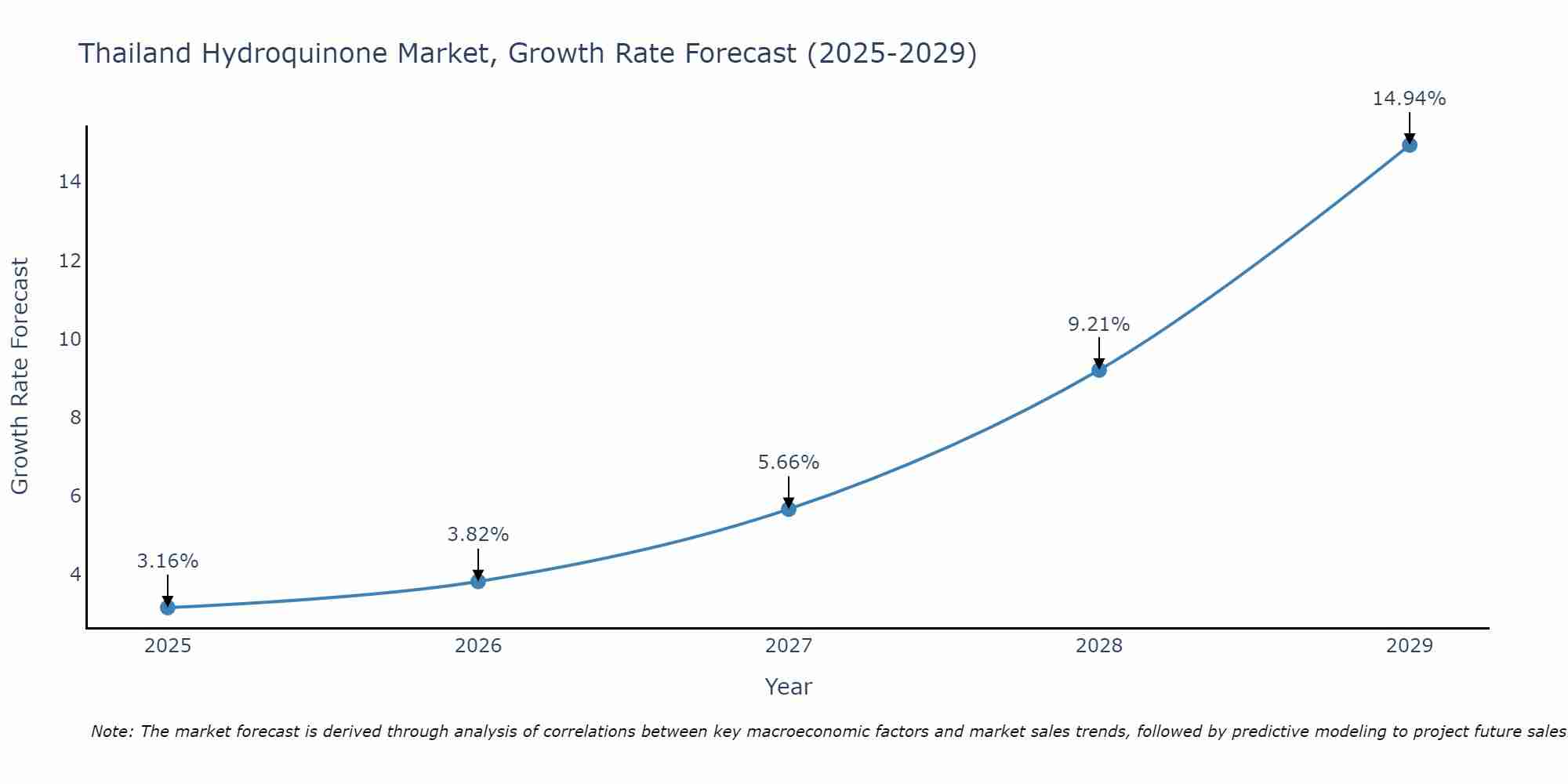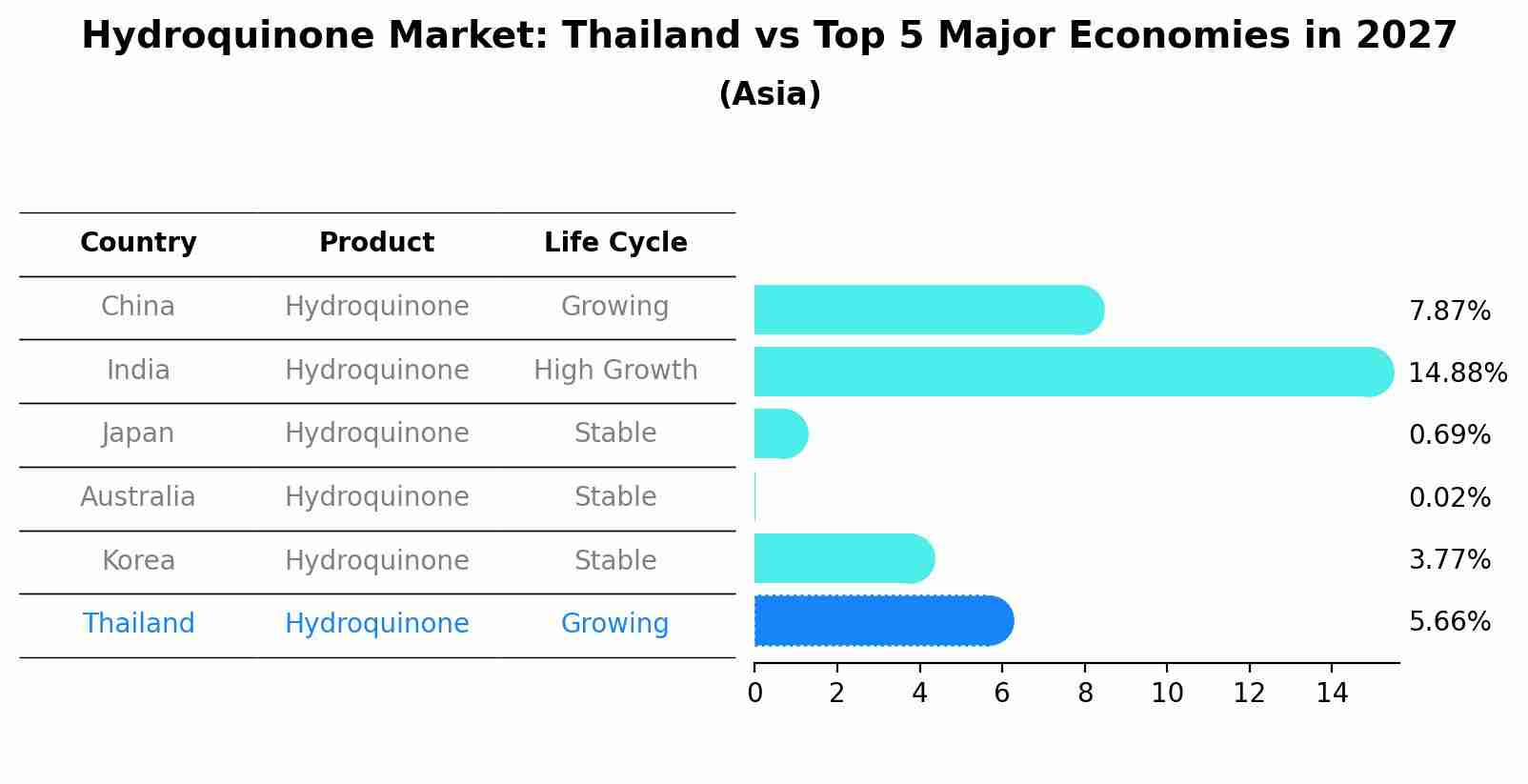Thailand Hydroquinone Market (2025-2031) Outlook | Growth, Industry, Companies, Share, Forecast, Size, Value, Trends, Analysis & Revenue
| Product Code: ETC414861 | Publication Date: Oct 2022 | Updated Date: Aug 2025 | Product Type: Market Research Report | |
| Publisher: 6Wresearch | No. of Pages: 75 | No. of Figures: 35 | No. of Tables: 20 | |
Thailand Hydroquinone Market Size Growth Rate
The Thailand Hydroquinone Market is poised for steady growth rate improvements from 2025 to 2029. From 3.16% in 2025, the growth rate steadily ascends to 14.94% in 2029.

Hydroquinone Market: Thailand vs Top 5 Major Economies in 2027 (Asia)
By 2027, the Hydroquinone market in Thailand is anticipated to reach a growth rate of 5.66%, as part of an increasingly competitive Asia region, where China remains at the forefront, supported by India, Japan, Australia and South Korea, driving innovations and market adoption across sectors.

Thailand Hydroquinone Market Synopsis
Hydroquinone is a chemical compound used in the cosmetics and skincare industry for its skin-lightening properties. The market for hydroquinone in Thailand is influenced by consumer preferences for skincare products and beauty standards. However, regulatory changes and concerns about the safety of hydroquinone have led to restrictions on its use in some countries. In Thailand, the market may be influenced by shifts towards more natural and safer skincare alternatives.
Drivers of the Market
The Thailand hydroquinone market is growing due to its applications in the cosmetic and healthcare industries. Hydroquinone is used as a skin-lightening agent and in the treatment of skin conditions such as hyperpigmentation. The increasing focus on personal grooming and skin care is driving the demand for hydroquinone-based products. Moreover, the pharmaceutical sector utilizes hydroquinone in the synthesis of certain medications, further contributing to market growth.
Challenges of the Market
The hydroquinone market in Thailand faces challenges related to regulatory restrictions and consumer concerns about skin safety. Hydroquinone is often used in skincare products to lighten skin, but concerns about potential side effects, including skin irritation and long-term health risks, have led to stricter regulations and consumer preferences for alternative ingredients. Adapting to these changing consumer demands and regulations is essential for market players.
COVID-19 Impact on the Market
The hydroquinone market in Thailand experienced both positive and negative effects during the COVID-19 pandemic. Hydroquinone is used in the cosmetics and personal care industry, and the lockdowns and restrictions initially led to decreased demand for such products. However, the focus on personal hygiene and skincare later resulted in a resurgence in demand. Supply chain disruptions and raw material shortages also affected production. Manufacturers had to innovate and adapt their business strategies to navigate these fluctuations, and the long-term market outlook depends on consumer behavior and economic recovery.
Key Players in the Market
The Thailand hydroquinone market features companies such as Great Lakes Fine Chemicals Co., Ltd., and Quimidroga Asia Pacific Co., Ltd., which specialize in the production and distribution of hydroquinone for cosmetics, pharmaceuticals, and other industries.
Key Highlights of the Report:
- Thailand Hydroquinone Market Outlook
- Market Size of Thailand Hydroquinone Market, 2024
- Forecast of Thailand Hydroquinone Market, 2031
- Historical Data and Forecast of Thailand Hydroquinone Revenues & Volume for the Period 2021-2031
- Thailand Hydroquinone Market Trend Evolution
- Thailand Hydroquinone Market Drivers and Challenges
- Thailand Hydroquinone Price Trends
- Thailand Hydroquinone Porter's Five Forces
- Thailand Hydroquinone Industry Life Cycle
- Historical Data and Forecast of Thailand Hydroquinone Market Revenues & Volume By Application for the Period 2021-2031
- Historical Data and Forecast of Thailand Hydroquinone Market Revenues & Volume By Intermediate for the Period 2021-2031
- Historical Data and Forecast of Thailand Hydroquinone Market Revenues & Volume By Antioxidant for the Period 2021-2031
- Historical Data and Forecast of Thailand Hydroquinone Market Revenues & Volume By Polymerization Inhibitor for the Period 2021-2031
- Historical Data and Forecast of Thailand Hydroquinone Market Revenues & Volume By Photosensitive Chemical for the Period 2021-2031
- Historical Data and Forecast of Thailand Hydroquinone Market Revenues & Volume By Others for the Period 2021-2031
- Historical Data and Forecast of Thailand Hydroquinone Market Revenues & Volume By End-Use for the Period 2021-2031
- Historical Data and Forecast of Thailand Hydroquinone Market Revenues & Volume By Cosmetics for the Period 2021-2031
- Historical Data and Forecast of Thailand Hydroquinone Market Revenues & Volume By Polymers for the Period 2021-2031
- Historical Data and Forecast of Thailand Hydroquinone Market Revenues & Volume By Paints & Adhesives for the Period 2021-2031
- Historical Data and Forecast of Thailand Hydroquinone Market Revenues & Volume By Rubber for the Period 2021-2031
- Historical Data and Forecast of Thailand Hydroquinone Market Revenues & Volume By Others for the Period 2021-2031
- Thailand Hydroquinone Import Export Trade Statistics
- Market Opportunity Assessment By Application
- Market Opportunity Assessment By End-Use
- Thailand Hydroquinone Top Companies Market Share
- Thailand Hydroquinone Competitive Benchmarking By Technical and Operational Parameters
- Thailand Hydroquinone Company Profiles
- Thailand Hydroquinone Key Strategic Recommendations
Frequently Asked Questions About the Market Study (FAQs):
1 Executive Summary |
2 Introduction |
2.1 Key Highlights of the Report |
2.2 Report Description |
2.3 Market Scope & Segmentation |
2.4 Research Methodology |
2.5 Assumptions |
3 Thailand Hydroquinone Market Overview |
3.1 Thailand Country Macro Economic Indicators |
3.2 Thailand Hydroquinone Market Revenues & Volume, 2021 & 2031F |
3.3 Thailand Hydroquinone Market - Industry Life Cycle |
3.4 Thailand Hydroquinone Market - Porter's Five Forces |
3.5 Thailand Hydroquinone Market Revenues & Volume Share, By Application , 2021 & 2031F |
3.6 Thailand Hydroquinone Market Revenues & Volume Share, By End-Use , 2021 & 2031F |
4 Thailand Hydroquinone Market Dynamics |
4.1 Impact Analysis |
4.2 Market Drivers |
4.2.1 Increasing demand for skin lightening products in Thailand |
4.2.2 Growth in the cosmetics and personal care industry in the region |
4.2.3 Rising disposable income leading to higher spending on beauty products |
4.3 Market Restraints |
4.3.1 Stringent regulations on the use of hydroquinone in cosmetic products |
4.3.2 Growing consumer awareness about the potential side effects of hydroquinone |
4.3.3 Competition from alternative skin lightening ingredients |
5 Thailand Hydroquinone Market Trends |
6 Thailand Hydroquinone Market, By Types |
6.1 Thailand Hydroquinone Market, By Application |
6.1.1 Overview and Analysis |
6.1.2 Thailand Hydroquinone Market Revenues & Volume, By Application , 2021-2031F |
6.1.3 Thailand Hydroquinone Market Revenues & Volume, By Intermediate, 2021-2031F |
6.1.4 Thailand Hydroquinone Market Revenues & Volume, By Antioxidant, 2021-2031F |
6.1.5 Thailand Hydroquinone Market Revenues & Volume, By Polymerization Inhibitor, 2021-2031F |
6.1.6 Thailand Hydroquinone Market Revenues & Volume, By Photosensitive Chemical, 2021-2031F |
6.1.7 Thailand Hydroquinone Market Revenues & Volume, By Others , 2021-2031F |
6.2 Thailand Hydroquinone Market, By End-Use |
6.2.1 Overview and Analysis |
6.2.2 Thailand Hydroquinone Market Revenues & Volume, By Cosmetics, 2021-2031F |
6.2.3 Thailand Hydroquinone Market Revenues & Volume, By Polymers, 2021-2031F |
6.2.4 Thailand Hydroquinone Market Revenues & Volume, By Paints & Adhesives, 2021-2031F |
6.2.5 Thailand Hydroquinone Market Revenues & Volume, By Rubber, 2021-2031F |
6.2.6 Thailand Hydroquinone Market Revenues & Volume, By Others, 2021-2031F |
7 Thailand Hydroquinone Market Import-Export Trade Statistics |
7.1 Thailand Hydroquinone Market Export to Major Countries |
7.2 Thailand Hydroquinone Market Imports from Major Countries |
8 Thailand Hydroquinone Market Key Performance Indicators |
8.1 Consumer perception and acceptance of hydroquinone in skincare products |
8.2 Research and development investment in finding safer alternatives to hydroquinone |
8.3 Regulatory approvals and compliance for the use of hydroquinone in cosmetics |
8.4 Market demand for hydroquinone-free or natural skincare products |
8.5 Trend analysis of sales of hydroquinone-based products versus non-hydroquinone products |
9 Thailand Hydroquinone Market - Opportunity Assessment |
9.1 Thailand Hydroquinone Market Opportunity Assessment, By Application , 2021 & 2031F |
9.2 Thailand Hydroquinone Market Opportunity Assessment, By End-Use , 2021 & 2031F |
10 Thailand Hydroquinone Market - Competitive Landscape |
10.1 Thailand Hydroquinone Market Revenue Share, By Companies, 2024 |
10.2 Thailand Hydroquinone Market Competitive Benchmarking, By Operating and Technical Parameters |
11 Company Profiles |
12 Recommendations |
13 Disclaimer |
- Single User License$ 1,995
- Department License$ 2,400
- Site License$ 3,120
- Global License$ 3,795
Search
Related Reports
- Vietnam System Integrator Market (2025-2031) | Size, Companies, Analysis, Industry, Value, Forecast, Growth, Trends, Revenue & Share
- ASEAN and Thailand Brain Health Supplements Market (2025-2031) | Strategy, Consumer Insights, Analysis, Investment Trends, Opportunities, Growth, Size, Share, Industry, Revenue, Segments, Value, Segmentation, Supply, Forecast, Restraints, Outlook, Competition, Drivers, Trends, Demand, Pricing Analysis, Competitive, Strategic Insights, Companies, Challenges
- ASEAN Bearings Market (2025-2031) | Strategy, Consumer Insights, Analysis, Investment Trends, Opportunities, Growth, Size, Share, Industry, Revenue, Segments, Value, Segmentation, Supply, Forecast, Restraints, Outlook, Competition, Drivers, Trends, Demand, Pricing Analysis, Competitive, Strategic Insights, Companies, Challenges
- Europe Flooring Market (2025-2031) | Outlook, Share, Industry, Trends, Forecast, Companies, Revenue, Size, Analysis, Growth & Value
- Saudi Arabia Manlift Market (2025-2031) | Outlook, Size, Growth, Trends, Companies, Industry, Revenue, Value, Share, Forecast & Analysis
- Uganda Excavator, Crane, and Wheel Loaders Market (2025-2031) | Strategy, Consumer Insights, Analysis, Investment Trends, Opportunities, Growth, Size, Share, Industry, Revenue, Segments, Value, Segmentation, Supply, Forecast, Restraints, Outlook, Competition, Drivers, Trends, Demand, Pricing Analysis, Competitive, Strategic Insights, Companies, Challenges
- Rwanda Excavator, Crane, and Wheel Loaders Market (2025-2031) | Strategy, Consumer Insights, Analysis, Investment Trends, Opportunities, Growth, Size, Share, Industry, Revenue, Segments, Value, Segmentation, Supply, Forecast, Restraints, Outlook, Competition, Drivers, Trends, Demand, Pricing Analysis, Competitive, Strategic Insights, Companies, Challenges
- Kenya Excavator, Crane, and Wheel Loaders Market (2025-2031) | Strategy, Consumer Insights, Analysis, Investment Trends, Opportunities, Growth, Size, Share, Industry, Revenue, Segments, Value, Segmentation, Supply, Forecast, Restraints, Outlook, Competition, Drivers, Trends, Demand, Pricing Analysis, Competitive, Strategic Insights, Companies, Challenges
- Angola Excavator, Crane, and Wheel Loaders Market (2025-2031) | Strategy, Consumer Insights, Analysis, Investment Trends, Opportunities, Growth, Size, Share, Industry, Revenue, Segments, Value, Segmentation, Supply, Forecast, Restraints, Outlook, Competition, Drivers, Trends, Demand, Pricing Analysis, Competitive, Strategic Insights, Companies, Challenges
- Israel Intelligent Transport System Market (2025-2031) | Strategy, Consumer Insights, Analysis, Investment Trends, Opportunities, Growth, Size, Share, Industry, Revenue, Segments, Value, Segmentation, Supply, Forecast, Restraints, Outlook, Competition, Drivers, Trends, Demand, Pricing Analysis, Competitive, Strategic Insights, Companies, Challenges
Industry Events and Analyst Meet
Our Clients
Whitepaper
- Middle East & Africa Commercial Security Market Click here to view more.
- Middle East & Africa Fire Safety Systems & Equipment Market Click here to view more.
- GCC Drone Market Click here to view more.
- Middle East Lighting Fixture Market Click here to view more.
- GCC Physical & Perimeter Security Market Click here to view more.
6WResearch In News
- Doha a strategic location for EV manufacturing hub: IPA Qatar
- Demand for luxury TVs surging in the GCC, says Samsung
- Empowering Growth: The Thriving Journey of Bangladesh’s Cable Industry
- Demand for luxury TVs surging in the GCC, says Samsung
- Video call with a traditional healer? Once unthinkable, it’s now common in South Africa
- Intelligent Buildings To Smooth GCC’s Path To Net Zero













